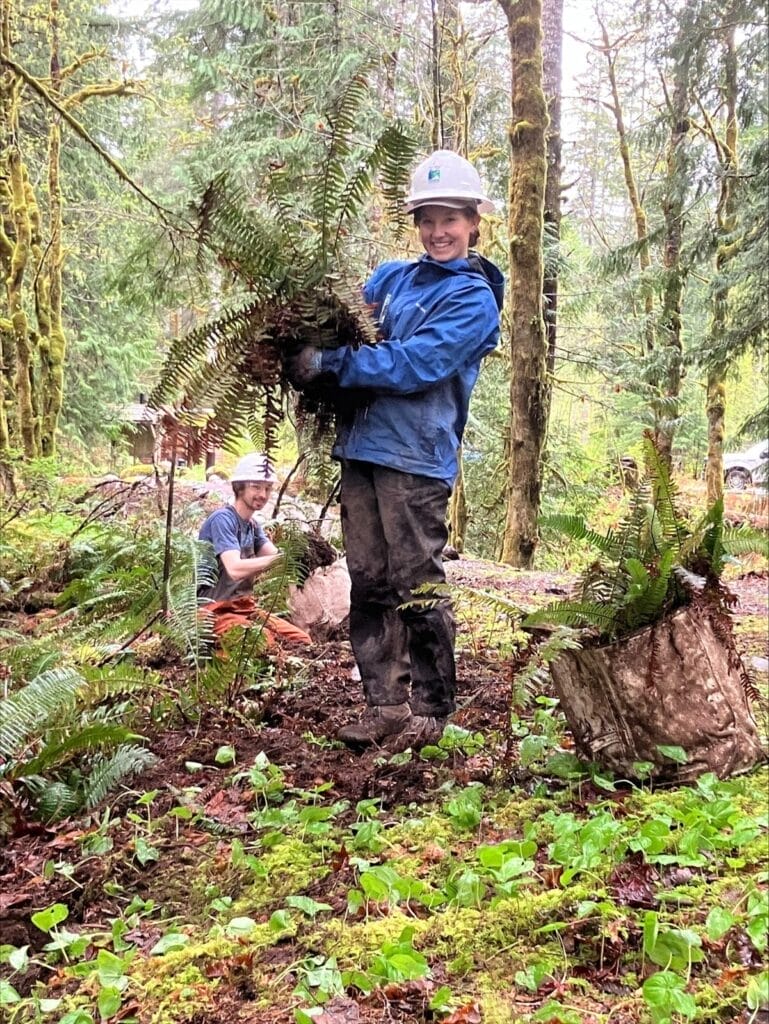5 Things I’ve Learned As a New Greenway Trust Trail Crew Member
My first morning on the Mountains to Sound Greenway Trust Trail Crew came with a lot of nerves. Months ago, I applied for the seasonal position because of my desire to work outdoors and curiosity to learn about land stewardship through the building and maintenance of trails. When I told friends and family about my new job, they would warn me about the “dirty and sweaty work,” or were concerned enough to ask whether I knew what I was getting myself into. My imposter syndrome was prevalent as I walked into the Greenway Trust’s field base with brand new work boots. Since my first morning on the job, it’s safe to say that I’ve learned a lot! Here are five things that stand out:

Trail Access and Intention:
Trails everywhere are designed and managed for specific modes of travel and use. For example, a remote backcountry trail used primarily by backpackers will not need to be as wide and developed as a popular trailhead and picnic area used by bikers, kayakers, and hikers. Each trail will have different management objectives depending on its designed use and trail class. This summer, the Greenway Trust Trail Crew has been constructing a new trail leading to a picnic area at the Middle Fork River Trailhead. We’ve created a consistent tread width of at least five feet, a gradual slope of less than five percent, and will be creating a compacted gravel surface to ensure it is accessible for users.
If you’d like to learn more about trail types and classes, the U.S. Forest Service uses a standardized set of interconnected concepts to define and apply management objectives to trails (learn more here).

Tool Maintenance:
Before I started, I couldn’t have told you what a Pulaski or Mcleod is. This month has taught me that trail crews are only as good as the tools they bring with them into the field. It’s important to plan a list of tools and double-check that you have all the necessary equipment before leaving the field base. Being well prepared is the best way to ensure progress in your fieldwork. Otherwise, it’s a bummer to try refilling your chainsaw with gas if you forgot a funnel and spill kit at the base. Each time a tool is used, we clean, sharpen, and dry them to keep everything in good condition and ready to use for next time.

Building With the Environment:
When it comes to trails, building with the natural environment is crucial. It’s important to consider how water will shed off of the trail, whether the surface might erode or compact, and if there are other hazards present such as hung-up trees or steep drops. The Greenway Trust hosted a volunteer event on the Granite Creek trail earlier this year to improve drainage and address areas where tread creep had occurred overtime. Our trail crew continued the volunteers’ work by cleaning out culverts and drains that had filled with natural leaf litter and debris, as well as digging new drains in sites where water could shed off the trail to prevent erosion and puddles from forming.

Teamwork:
Working together as a crew to split up and coordinate tasks is the best way to accomplish our goals. Our trail crew partnered with the National Forest Service on a restoration project aimed to plant native vegetation and mulch a recent construction zone for a new parking lot at the Denny Creek Trailhead. That morning we worked together to plant native salmonberry, sitka spruce, and douglas fir. In the afternoon, we divided into teams shoveling mulch from the truck into wheelbarrows, another team pushing the wheelbarrows to bare patches forming piles, and a final team with rakes spreading the mulch evenly. By streamlining the process, it was impressive what our small team could accomplish in a day. We revegetated the entire hillside!

Sustainable Trails:
The Greenway Trust builds sustainable trails that are meant to last for generations. Sustainable trails lead users to their desired destinations while avoiding steep slopes, critical habitats, and other sensitive areas. Ideally, sustainable trails are constructed with all natural and locally-sourced materials. Our trail crew has built multiple rock walls this season to reinforce the sides of trails, increase soil retention, and prevent erosion. To build these rock walls, we source large rocks from the surrounding area and set them in place by aligning them with each other and maximizing the points of contact between rocks. Then, we fill in any gaps with medium sized rocks for additional support. Lastly, small rocks and pebbles fill any remaining empty space. You know you’ve built a sturdy wall if you can dance and jump around on it without any rocks shifting. By using these natural materials, we avoid the risk of introducing invasive species and plan for the long term use and sustainability of the trails we construct.

A lot of planning and effort goes into the construction and maintenance of trails, and I’m grateful for this experience to practice daily land stewardship in the Mountains to Sound Greenway National Heritage Area. I’ll never be able to hike another trail without inspecting drainage, slope, and tread ever again.
Want to get yours hands dirty as a volunteer in the Greenway NHA? Check out our upcoming events!





